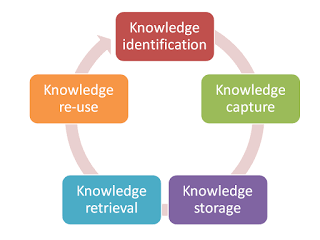3 problems with the simple "capture-led cycle" model for KM
There is a common diagram in use in the KM profession, which has at least 3 major flaws, so apply it with caution.
 |
I am going to be contentious again in this (reprised) post, and draw attention to the failings of a very common KM model. I do this because I think we can do better, and because this model draws us into narrowed ways of thought that can cause us to miss opportunities.
This is a very common sort of picture in the KM world – a one-way learning loop with “knowledge capture” or “knowledge collection” as step 1 or step 2. Here is a version I drew just for this blog post, but you can find many other examples.
Simple and seductive as this model is, there are three main flaws which you need to be aware of if the model is not to lead you astray.
Firstly, knowledge doesn’t have to be captured, to be managed.
Your cycle does not need to start with capture. Indeed, capture is not always possible. As Stephen Denning pointed out, there is some knowledge that can be collected or captured (he calls it precision knowledge) and some that cannot (he calls it intuitive knowledge). He concludes that “It is only in the area of precision knowledge that a knowledge collection (captured knowledge) will offer a clear guide to action”.
Can you manage knowledge if it is not captured? Sure you can – you manage it through conversation – through arranging the right conversations between the right people;
- conversation within the team, for example through after action reviews
- conversation from on team to another, for example through peer assist or knowledge handover
- conversation within a community of practice, for example through knowledge exchange
- conversation from one person to another, through mentoring, coaching, knowledge interviewing
Secondly the model is a one-way push model, with no room for Pull.
The cycle starts with a piece of knowledge which needs to be captured. There is no indication in the loop that there is a need or a demand for that knowledge – only an arrow from “knowledge” to “capture”. It does not start with the user in mind, but with the supplier in mind, and I think that’s the wrong perspective.
Thirdly the model usually has no place for co-creation of knowledge.
It usually is seen as a transaction flow from knowledge creator to knowledge re-user, but we know that these flows are not simple, and that when they work well knowledge is not transferred like a unit – like a bolt in a piece of machinery – but changes its nature with every interaction. As people discuss what they have learned in a lesson capture meeting, they co-create the knowledge through conversation. As knowledge is stored in a wiki (for example), it is co-created through interactions in the wiki, as new insights are added and misconceptions removed. As knowledge is shared in a community of practice discussion, it changes again, growing and becoming more robust with each interaction. The knowledge user adds new knowledge to what they already know.
The dangers of this model
The model is not wrong, it is just only part of the story, and applies only in certain cases. It works for lesson-learning, for example, although lesson learning has way more steps than shown here, and lesson learning includes the missing co-creation step. For other elements of KM within your organisation – its insufficient and misleading.

Leave a Reply